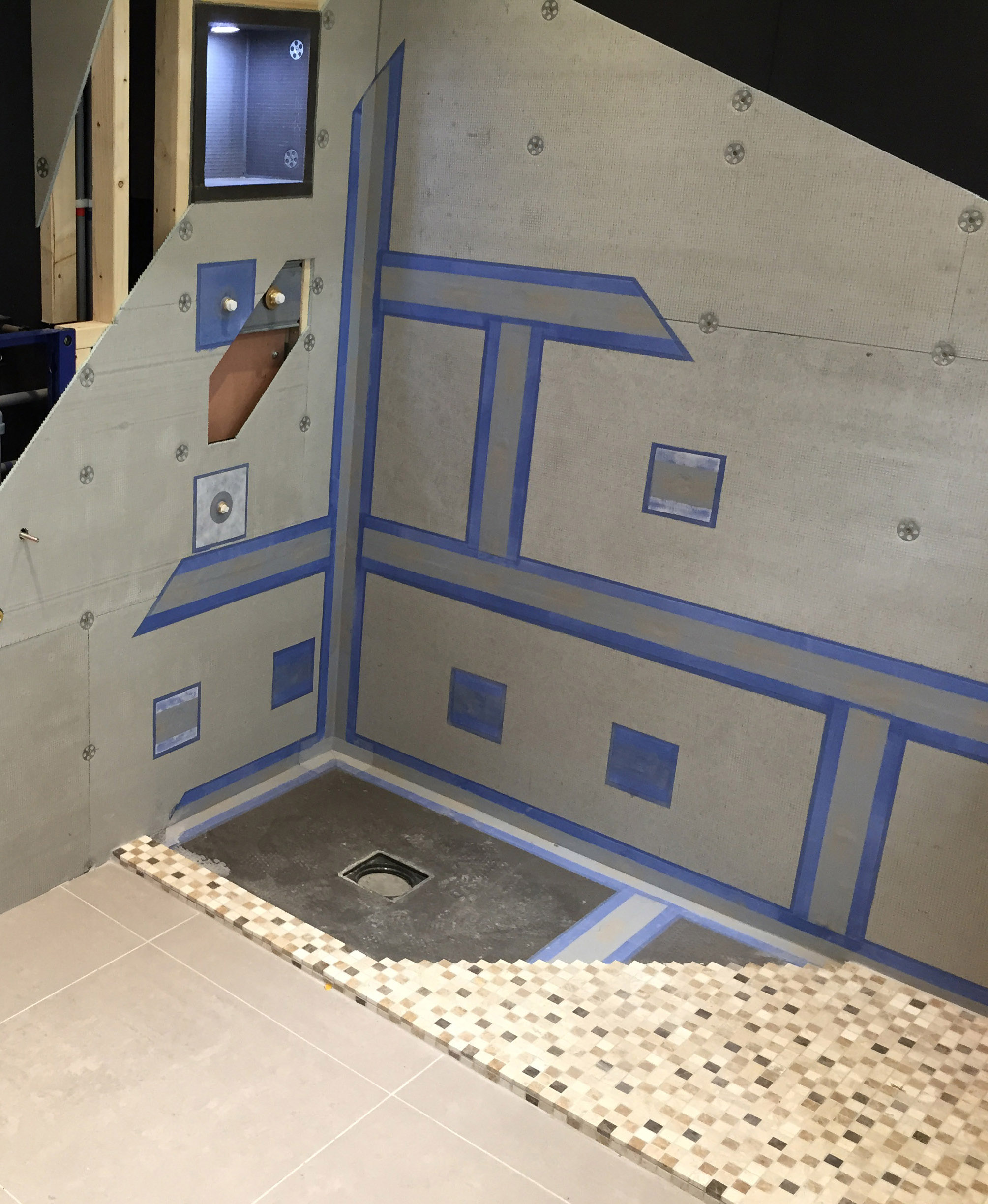Imagine stepping into your meticulously designed bathroom, only to discover a stubborn water stain creeping up your beautiful tilework. Disaster! While this scenario may seem daunting, it’s a common problem that can be easily avoided with proper waterproofing. But does every bathroom need this extra layer of protection? The answer, much like a good shower, is a resounding “it depends.”

Image: bathroomposter.blogspot.com
Waterproofing a bathroom floor before tiling is an essential step that prevents leaks, mold growth, and costly repairs. By creating a barrier that repels moisture, you’re safeguarding your home’s foundation and extending the lifespan of your gorgeous tiles. This article will delve into the world of bathroom waterproofing, demystifying the intricacies and empowering you to make informed decisions about your next bathroom makeover.
Understanding The Importance of Waterproofing
The primary function of waterproofing is to prevent water from seeping into the subfloor and causing damage. Unlike other rooms in your home, the bathroom is exposed to a high volume of water due to showers, baths, and splashes. Water penetration into the subfloor can lead to:
- Mold and Mildew Growth: Moisture-loving microorganisms thrive in damp environments, leading to unpleasant musty odors and potential health hazards like respiratory issues.
- Structural Damage: Wood subfloors warp, rot, and deteriorate when constantly exposed to moisture, leading to costly repairs and even safety concerns.
- Increased Energy Bills: Dampness affects insulation, making your home less energy-efficient and raising your heating and cooling costs.
Who Needs Bathroom Waterproofing?
While waterproofing isn’t universally required in every bathroom, certain scenarios necessitate this extra precautionary measure:
- New Construction: Waterproofing is generally recommended during new construction to prevent future issues from the start. It’s a proactive approach that safeguards your investment.
- Existing Bathrooms with Known Issues: If your bathroom has experienced leaks or water damage in the past, waterproofing is crucial to address the root cause and prevent recurrence.
- Bathrooms with Specific Features: Showers, bathtubs, and wet rooms are prime candidates for waterproofing due to their constant exposure to water.
- Bathrooms with Floor Drains: Floors with drains require extra waterproofing to ensure adequate drainage and prevent stagnant water.
What Types of Waterproofing Are Available?
The world of bathroom waterproofing offers a diverse range of options, each with its own pros and cons:

Image: www.workshop.bunnings.com.au
1. Membrane Waterproofing:
- Material: Thin sheets of synthetic material like PVC, polyethylene, or rubber.
- Application: Rolled out over the subfloor, seams are carefully sealed, and the membrane is adhered to the walls.
- Pros: Affordable, easy to install, available in various thicknesses and forms.
- Cons: Susceptible to punctures, less durable than some other options.
2. Liquid Waterproofing:
- Material: Liquid polymer-based solutions that create a waterproof seal.
- Application: Applied by brush or roller onto the subfloor in multiple layers.
- Pros: Conforms to irregular shapes, creates a seamless barrier, highly durable.
- Cons: Initial investment is higher, requires thorough application for optimal results.
3. Mortar-Based Waterproofing:
- Material: Cement-based mortar formulations that form a waterproof layer.
- Application: Applied like traditional mortar, achieving a thick, waterproof coat.
- Pros: Extremely robust, durable, excellent for high-traffic areas.
- Cons: Requires skilled installation, labor-intensive, can be prone to cracking if not applied correctly.
Choosing the Right Waterproofing Method:
The best waterproofing method for your bathroom depends on several factors:
- Budget: Membrane waterproofing offers a cost-effective solution, while liquid and mortar-based systems can be more expensive.
- Existing Subfloor: Consider the subfloor material and its condition. Different waterproofing methods are suitable for wood, concrete, or other subfloor types.
- Installation Complexity: Some methods are easier to install than others, impacting labor costs and overall project duration.
- Aesthetic Preferences: Some waterproofing methods may be visible beneath the tile, so consider your desired aesthetic.
Steps Involved in Waterproofing a Bathroom Floor:
Here’s a general overview of the process, keeping in mind that specific steps may vary based on the chosen method:
- Prepare the Subfloor: Thoroughly clean and repair any cracks, gaps, or unevenness in the existing subfloor.
- Install Waterproofing: Apply the chosen waterproofing method according to the manufacturer’s instructions. Ensure proper coverage and adhesion.
- Create a Slope: Ensure the floor slopes towards the drain (if applicable) to facilitate water drainage.
- Lay the Tiles: Once the waterproofing is fully dry, install your chosen bathroom tiles, following standard tiling techniques.
- Grout and Seal: Properly grout and seal the tiles to prevent moisture penetration and enhance aesthetic appeal.
Essential Tips for Waterproofing Success:
To maximize your chances of a successful waterproofing project and a long-lasting, leak-free bathroom, keep these tips in mind:
- Hire a Professional: While DIY waterproofing is possible for some, it’s recommended to hire a skilled and experienced contractor for complex installations and critical areas.
- Follow Manufacturer’s Instructions: Carefully read and adhere to the guidelines provided by the waterproofing product manufacturer for optimal results.
- Check for Leaks: After completing the waterproofing, test for leaks by creating a simulated shower environment to ensure the barrier is effectively preventing water penetration.
- Maintenance is Key: Conduct regular maintenance checks and repairs if necessary to keep your waterproofing system in top condition over time.
Do You Have To Waterproof A Bathroom Floor Before Tiling
https://youtube.com/watch?v=9R9kfoAJVbQ
Conclusion:
Waterproofing a bathroom floor before tiling is a wise investment that protects your home from costly damages, unpleasant odors, and potential health hazards. Choosing the right waterproofing method, collaborating with skilled professionals, and diligently adhering to best practices will safeguard your bathroom for years to come. So go ahead, create the bathroom of your dreams, knowing that every splash and shower is protected by a reliable waterproof barrier.
Do you have any personal experiences with bathroom waterproofing? Share your stories and advice in the comments below. Let’s continue the conversation and make sure every bathroom is a haven of style and comfort!






